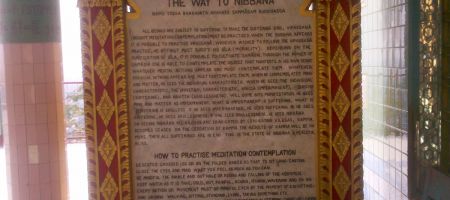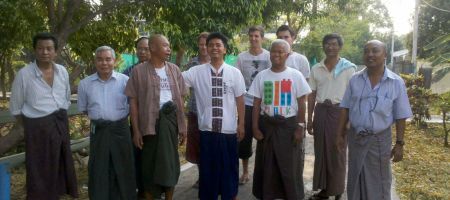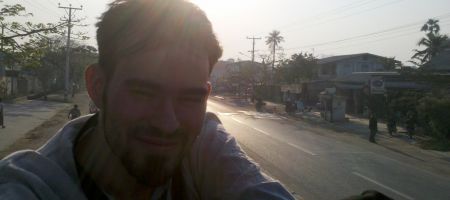Vipassana
So, I have promised you to write a bit about my experiences at the 10 day meditation training at the Dhamma Mandala Vipassana meditation centre near Mandalay, Myanmar.
What is Vipassana meditation?
In a nutshell, it ought to be the mediation technique taught by The Buddha. A path that leads to the liberation in Nirwana (which is not a place!).
The goal is to acknowledge certain truths exclusively through objective observation of your mind and bodily sensations. It is a practice, not an intellectual teaching. So the the teachings are not about that you understand and acknowledge them on an intellectual level but that you experience these truths yourself and in effect gain wisdom, not just knowledge.
In my own words, I would describe the practice as the training to create another, separate, level of conscience that is not influenced by the subconsciousness, bodily sensations and thoughts that wander through the mind. Rather, you are to objectively observe them.
Through the objective observation and the acknowledgement of the impermanent nature of even the tiniest of sensations that you’d normally only feel subconsciously, you train yourself to see things more equanimous. This effectively eliminates your hatred, aversions and desires as you find out for yourself through the practice that those things are merely a product of your subconsciousness, something you have no control over and could be described as a simple bodily function, an automaton, that only acts on the various bodily sensations as input and affections + aversions and actions as output.
By experiencing these sensations consciously, with an equanimous mind instead and not reacting to them, you annul this function. That is the goal. But on the path to it, you continue to diminish it, just like your affections and aversions.
This has advantages on its own, you get more balanced in life, e.g. not get so worked up about what someone said, or did, or didn’t do, about yourself etc. – again, not by acknowledgement but through insight, through practice.
And if you advance further, and you will start to ask yourself – based on your own insights – the question what is the real you, by what are you, your mind defined?
Your subconscious is nothing you can control, just a bodily function like the heartbeat. But this is not you, nor can anything it produces be part of the “core” you, so to say. And, you will find out that you haven’t really been in control of yourself your whole life, that you have been controlled by your subconsciousness, that you thought the things that made you are in fact only a product of it, sensation and reaction, sensation and reaction, sensation and reaction.
The real truth of what you are, what defines you lies deeper within yourself, beyond your affections and aversions, your subconsciousness. And finding this is finding liberation, enlightenment.
So this is the theory. But as I said, and as the teaching explicitly says: It is a practice. So the theory is not important. If the teachings say, “you will experience A and it will lead to B”, then, don’t accept it until you can validate this for yourself through own experience. Don’t believe.
This is one thing I like about the teachings and which distinguishes them from religious texts.

This stone inscription in a Buddhist temple explained the different steps in the practice quite well in English, read it (Samadhi = right concentration). Most of the practice consists of 1. training the right concentration of mind and 2. sharpening your senses to observe bodily sensations.
That “in a nutshell” description got longer than intended. But if you are curious to learn more, perhaps written in a better structured manner, do read about it on their website www.dhamma.org or on the wikipedia (I’m linking to the German article here because I think it is better).
So, a few words about the actual training.
About 50 students attended the course, of which only 7 were foreigners (4 of them Germans) and no hippies. Most students were 40 and up, there were about as many women as men. 3 Buddhist monks participated as students. The students were strictly separated between sexes, we lived in separate areas and had no contact whatsoever with the women other than during group meditation (where they were also strictly separated) to avoid any possible distractions from meditation.

Some of the male students (after the course)
During dry season, when I was there, the surrounding landscape was very dry, there was no grass, the trees withered and dropped their leaves as if it were autumn – at 32°C. Generally of course, that didn’t matter much because we were there to meditate and not admire the landscape. We weren’t allowed to go out of the centre anyway or have any other contact with the outside world or any other students (“noble silence” for the entire duration of the course). The reason for this should be clear – to not add distractions that keep us from meditating.
The accommodation was very basic. It consisted of small bungalows with wooden beds (without mattresses) and without fans. The latter making it unbearable to be inside during daytime, which was kinda okay because we’d meditate in the Dhamma hall during the day. The former is something I was able to get used to during the course as I was so exhausted at the end of the day that I could also have slept on rocks.
Then there was the Dhamma hall (the place for group meditation) in which we spent most of the day sitting cross- or otherwise-legged.
However, as a negative point, as I found out during the first days, there are all sorts of (etiquette) rules for the Dhamma hall – how you may sit, where you may sit, where you may look (I think, not sure!), what you may do, when you may stand up or go out of the room (to stretch the legs, make a pause), when or how to address the teacher etc. Because of this, I always felt a bit uneasy in the hall because the atmosphere there seemed so stiff and I never knew if I got to know now all the rules or if I will put my foot in one’s mouth another time if I do this or that. This has nothing to do with the teachings of Vipassana. It is just that the Myanmese are more traditional and have certain customs how this kind of thing is organized.
So, that is why I preferred to go to the meditation cell complex whenever the teacher gave permission after the group meditation. I couldn’t just meditate anywhere I liked but everyone always went to the hall first and be given instructions by the teacher. This may also be only the case in more traditional / strict centres in Myanmar, I don’t know. (I also didn’t like that: Just like all these rules in the Dhamma hall, it caused my mind to get distracted by negative and rebellious thoughts about the organisation of the whole thing making it harder for me to focus on the actual meditation.)
The meditation cells were basically small solitary cells. Everything in that complex was out of concrete, which was good because it kept the place reasonably cool during the hot afternoon and the monotony of the cell gave my mind very little things to get distracted with. We got assigned a cell we could go to (instead of the Dhamma hall) on the 5th day I think.
I couldn’t help but grin when I first went to the place after we got one cell assigned. It really looked like how one imagines a solitary prison cell. Still, we really welcomed the option to meditate in this room from then on, kind of a privilege, “finally something new” ;-).
As an acquaintance put it, Vipassana is no feel-good-meditation. Yes, there are other meditation techniques that are less hard than Vipassana and which also bring you certain advantages, make you more balanced in daily life etc.; But they do not strive for the highest goal, the liberation, enlightenment. Vipassana on the other hand is hard. And it makes you feel miserable, especially with an untrained mind (on the first course).
I really had to struggle with my mind and motivation, especially in the first days, but really during most of the training.
My mind was rebelling against this attempt to control it, to focus my attention on something so…. boring like the breath for more than a few minutes. It was exhausting. My mind wanted some input, something to busy itself with. It started to wander off, think and dream about this and that, getting angry or sad about so many things from my memory all the time and it took all my dedication to bring it back to the subject, the reason why I was there in the first place, to learn about and practice, give the meditation technique a chance, to bring it back to simply observe, just observe.
The mind is such a monkey. Just try, try to concentrate on anything, like for example your finger, for a few minutes….
It takes much patience to tame the mind to do what you want. Perhaps an early insight one has in meditation, that you don’t have your own mind under control. (I say to myself: “so what do you have under control if not even your own mind, eh?!”).
One reason I struggled so hard with it was because I didn’t come there with the right motivation. I came there most of all because I was curious, intellectually, about this kind of meditation. I did not expect this amount, or better, this intensity of training. I keep using the word training rather than course because it really is training and very little theory. That is what meditation is about after all.
The daily schedule was packed with sitting in meditation from 4:30 AM to 9:00 PM except for about one hour of discourse and the only breaks being the breakfast, lunch and late afternoon break (no food after lunch). We had about six hours sleep a night on said beds.
So, intellectual curiosity is not the right motivation. It takes a willful intent. If you intend to do a course, inform yourself thoroughly about what awaits you, make yourself no illusions, it is hard stuff. But it is the real thing, so it is worth it.

The bus back from the meditation centre

On the bus back to Mandalay: Ahh, exhausted but free again!
P.S: It took me one hell of an effort to write that all down. It is a huge article now, so please at least comment if you read the article with interest.
